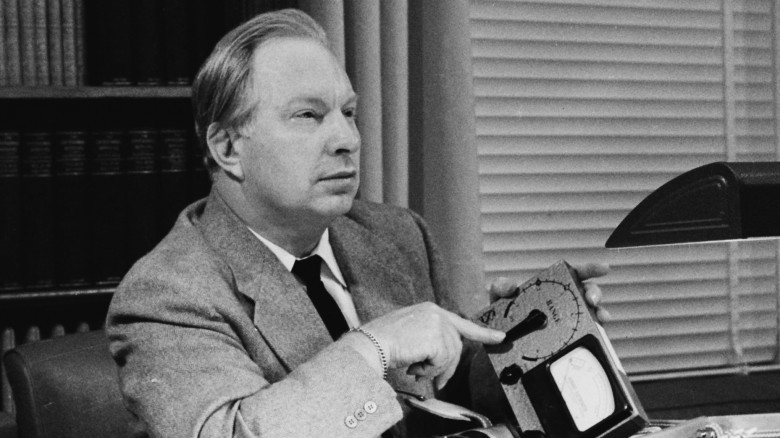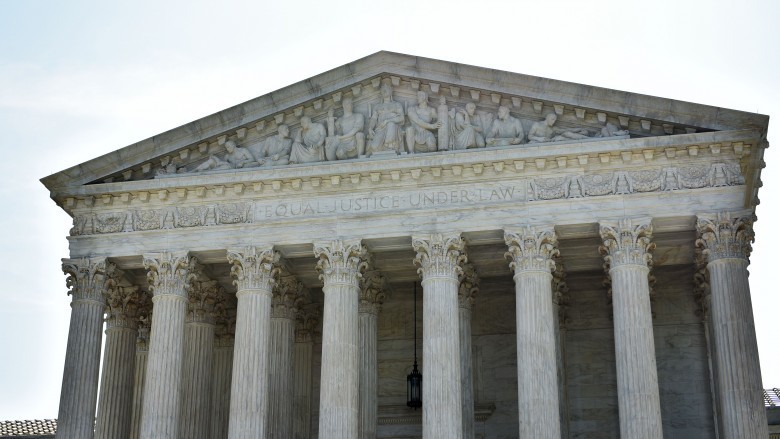
Getty Images
People have a deep-seated need to belong — it's why our disastrous elections go the way they do. And sometimes, this leads people to join a bona fide cult, which gains steam and fame till the rest of us can just bang our heads against the wall and wonder how and why. Is the world really such an isolating place that people believe anything they're told under the guise of belonging and bettering themselves?
The Church of Scientology, labeled as a cult by defectors and detractors alike, has somehow gained a prestigious mass following. Here are a few things we do know about the strange pseudo-religion.
It was originally a self-help book

Getty Images
In 1952, American author L. Ron Hubbard wrote a self-help book called Dianetics: The Modern Science of Mental Health, a compendium we can best describe as a "hot mess." It drew its beliefs from Hubbard's personal experience, the rudiments of Eastern philosophy, and, of all places, the work of Sigmund Freud.
Distributed through the Dianetic Foundation, the book gained some acclaim, until the Foundation went bankrupt. In 1954, Hubbard, in his money-grubbing genius, decided to rebrand the self-help book as a religion and call it Scientology. This seems like a perfectly harmless solution to a temporary problem, right? If only the weirdness stopped here.
You're locked in for a billion years

Getty Images
Scientology gained critical acclaim and popularity at an alarming rate through the years, and unlike most religions, where joining requires a simple phrase, a simple mock-drowning, or perhaps a sacrifice or two, Scientology requires all its members to pay a fee to join. Even worse than paying exorbitant amounts of money, Scientology requires its members to sign a contract promising to serve the faith for a billion years.
A billion. Years.
We don't know about you guys, but we thought the average human lifespan was around 80 years or so. And even people who were alive back in biblical times have only been hanging around heaven now for a few thousand years, so it really seems like Scientology's contract lawyers are a tad overzealous.
You have to pay to play

Getty Images
A lot more about that membership fee came out in a recent exposé on Scientology's cult status. Former Scientologist Leah Remini revealed that newly initiated members are required to pay fees ranging from $1 per hour to $1,200 for courses to reach the supposed "next level." The first stage is called "Clear," and if that sounds like complete nonsense to you, congratulations: you're well on your way to understanding Scientology.
The gag is that this is a continuous process, forcing members to continue to pay to ascend to a level of knowledge that does not even exist. It's the perfect con for the impressionable and gullible.
It is very specific in targeting celebrities

Getty Images
While most gangs and cults tend to draw the outcasts of society (low-income populations, vulnerable groups), Scientology defies convention in that its target demographic is the rich and famous. In 1955, Hubbard specified that targeting celebrities "just past or approaching their prime" was crucial to spreading the word, not to mention an easy way to bankroll the entire operation. An initial $1,500 fee is nothing to someone whose net worth would make the average citizen gag from all the zeroes.
Some of Scientology's most notable faces are Tom Cruise, John Travolta, Doug E. Fresh, and even Beck.
Should we be worried? Beck's pretty awesome, so yes. We should be worried.
It runs what amounts to a prison camp
The FBI has been investigating the Church of Scientology for human trafficking violations for the last few years. This started with the discovery that their camp, called Sea Org, was making its members work for $50 a week or less.
In the HBO documentary Going Clear, former Scientologist Sylvia Taylor revealed that she was sent to a place called Rehabilitation Project Force. Sylvia had been a liaison between the Church and John Travolta, and she described the Rehabilitation Project Force as a prison camp in which people were forced to do 30 hours of hard labor with just three hours off. They were also forced to eat table scraps and sleep on dirty wet mattresses. The living conditions sucked, the work sucked, and no one was paid for their labor.
There is a word for this, and it rhymes with Avery.
The Big Bad in Scientology is an alien

Getty Images
This is not an exaggeration. Much like in the Abrahamic faiths, where a good and a bad entity battle over the soul of humanity, there is a good and bad in Scientology. The difference is that the bad in this case is an alien named Xenu from approximately 75 million years ago (before the dawn of humanity, mind you).
During his time, Xenu reigned over a confederation of about 90 or so planets, including ours (then called "Teegeeack"). Due to overpopulation — a common theme in many sci-fi works — Xenu launched a mass genocide of his people by transporting excess individuals to Earth to be dumped into volcanoes.
We're starting to wish we were making this up.
Xenu's nuclear bombs released evil spirits

Getty Images
After dumping these people at the volcanic bus stops, Xenu then dropped H-bombs more powerful than anything humanity has engineered to destroy the bodies but free the souls. These evil souls are called Thetans.
We really wish we were making this up. This sounds like every bad, pulpy science fiction novel ever written in the last 30 years. This sounds like a film and not a religion, one we could feel good about poking fun at on Mystery Science Theater 3000. And it sounds entirely expected because Hubbard, of course, was a science fiction author.
They don't let members escape

Getty Images
Scientology purports that its members can be of any religion they choose and still be a Scientologist. It also purports that members are free to leave for any reason at any time. We don't know about you guys, but when someone makes overtures stating you can go at any time, it makes us wary.
And we're right to feel that way. In her interview, Leah Remini states that members who left or broke faith with Scientology often found themselves the targets of smear campaigns. Those who left the camps (like Sea Org) were often sent a bill for room, board, food, and other miscellaneous fees accrued during their internment, despite Scientology claiming it charges nothing for staying there.
In short, Scientology is a scam that abuses its members — and then smears them when they walk away.
If you do escape, you'll suffer

Getty Images
Another bizarre revelation in the documentary Going Clear was that members who cut ties with the Church are forcibly ostracized by their own Scientologist family members. They call it "disconnecting."
The reasoning of those in charge is that any members of the Church with fleeing family are at risk for being Suppressive Persons (people who block the entire enlightenment spiel Scientology pitches). In the documentary, those who left admit they have not seen their family members for many years after leaving the religion, seriously putting the "strange" in "estrangement."
Authorities are finally cracking down on them

Getty Images
All signs point to Scientology as an elaborate scam set up as an organized religion and masquerading as a self-help organization. It meets all the requirements of a cult. Virtually every documentary interviewing former members points to this. So why is Scientology accepted as a legitimate religion?
Well, as of 2016, it's not. The Supreme Court revoked Scientology's tax-exempt status unanimously, saying it could operate as a business but not as a religious organization. This is coming on the heels of a surprisingly short investigation by the FBI. Our guess is all those former members coming forward and exposing Scientology's expensive skeletons in their adamantly locked closets had something to do with the decision. It seems 2016 yielded a few good things before taking us on the crazy train to oblivion.